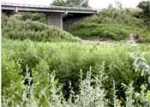African Invader

The theme of some of Hollywood's most memorable "B" movies has come to the shores of Swanson Lake and the Republican River channel.
Like the invasion movies of the past, a plant has invaded the beaches along the shore line of the Southwestern Nebraska lake and river, threatening wild life, vegetation and precious water resources. The shrub, known as the salt cedar or tamarisk plant has found a new home near Macklin Bay west of Trenton.
Salt cedar, which can grow to 20 feet in height is a plant native to North Africa, the Mediterranean and the Middle East. Introduced to the United States in the 1850s as ornamental plants and for use in erosion control, tamarisk has spread into natural wetlands where it tends to form dense thickets along streams and springs.
The plant chokes out native vegetation such as cottonwood, willow and mesquite trees. It has taken over nearly one million acres of wetland in the Southwestern region of the U.S.
The drought in Southwest Nebraska has contributed to the infestation in the Trenton area. The plant thrives in arid climates and prefers a very saline rich and nutrient poor soil. During the spring, it can grow as much as one foot a month and spreads up to 500,000 seeds each year. It also spreads by root, trunk and branch sprouts.
The plant will eliminate native vegetation because of its high demand for water. A single large tamarisk can transpire up to 300 gallons of water a day. The plant can severely limit available water or completely eliminate a water source in areas where watercourses are small or intermittent.
Tamarisk grows in salty regions, eliminating the salt from the tips of its leaves. When the leaves are shed, the salt from the leaves leaches into the ground around the trees increasing the salinity of the soil and further reducing the native plant's ability to thrive.
Because tamarisk has little nutritional value and eliminates natural habitat, the plant can also be extremely detrimental to wildlife. In a study along the Colorado River, tamarisk stands supported less than one percent of the winter bird life that would have been found in a native plant stand of the same size.
Volunteers are needed to help rid the Swanson Reservoir of this invasive plant.
In a cooperative effort to rid Swanson Reservoir of the plant, a salt cedar workday has been arranged for Wednesday, Aug. 14, by the Region 6 Weed Superintendents, the Nebraska Department of Agriculture, the Nebraska Weed Control Association, the Bureau of Reclamation, the Nebraska Game and Parks Commission, BASG Chemical Company and Van Deist Supply Company of McCook.
The workday will begin at 10 a.m. at the Weed Superintendent's office. Volunteers will then go to the Trail 3 boat ramp and begin spraying the tamarisk plants, working toward Macklin Bay.
Following lunch, volunteers will hear from guest speakers Meghan Dinkins, UNL graduate student conducting bio-research at Swanson Reservoir and Ryan Martin of Nebraska Game and Parks regarding the noxious weed plan at Swanson Reservoir. For more information on this or other noxious or invasive plants, contact Rick Hedke, Weed Control Supervisor at (308) 334-5851.
